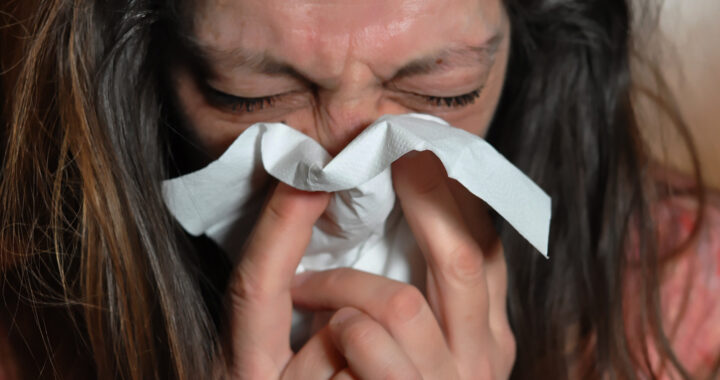Breast cancer patients who have achieved remission, even after many years or decades, may still need to exercise caution regarding respiratory infections. A new study, which was published on 20 Jul 2025 in Nature, has discovered that common respiratory viruses such as influenza and SARS‑CoV‑2 can awaken dormant breast cancer cells lodged in the lungs. S. B. Chia et al. discovered how viral infections can transform silent cancer cells into active metastatic lesions and increase cancer mortality risks years after initial treatment and remission.
Common Respiratory Viruses and Respiratory Infections Like Flu and COVID-19 May Reactivate Dormant Breast Cancer Cells According to Study
Background
Breast cancer is the second most commonly diagnosed cancer in women globally. Most deaths arise from metastases that can emerge years or decades after remission. Dormant disseminated cancer cells may linger in organs like the lungs, bone, or liver before reactivating. Understanding triggers that disrupt this dormancy is critical to preventing metastasis. The researchers wanted to know if respiratory infections can trigger the reactivation of these cancer cells.
Researchers first used mouse models of breast cancer, specifically MMTV‑Her2 transgenic mice, which developed tumors that released and seeded dormant cancer cells into the lungs. They then exposed these mice to common respiratory viruses, specifically influenza A and a mouse‑adapted SARS‑CoV‑2 strain, after establishing dormancy. This setup allowed them to observe whether viral infection could awaken quiescent cancer cells.
Lung tissue was examined through histology, immunofluorescence, and bioluminescent imaging to detect changes in cell activity. Proliferation markers and quantified metastatic growth over time were identified. Additional experiments measured inflammatory cytokines like interleukin‑6 and profiled immune cell behavior through flow cytometry and single‑cell RNA sequencing, while further focusing on CD4 positive and CD8 positive T cells interactions.
The researchers analyzed two major datasets to extend the findings to humans. The U.K. Biobank cohort tracked cancer survivors in the U.K. with and without SARS‑CoV‑2 infections to assess cancer‑related mortality. The U.S. Flatiron Health database, moreover, documented thousands of breast cancer patients in the U.S. to evaluate whether COVID‑19 infection correlated with increased incidence of lung metastasis over multiple years.
Key Findings
• Respiratory Viruses Can Reactivate Dormant Cells: The study found that respiratory viruses such as influenza and SARS‑CoV‑2 can awaken dormant breast cancer cells in the lungs. Previously inactive cancer cells began proliferating rapidly following infection. This led to the formation of visible metastatic lesions within weeks in mouse models.
• Interleukin‑6 Drives the Reactivation: Analysis revealed that the cytokine interleukin‑6 or IL‑6, which spikes during respiratory infections, plays a central role in reactivating dormant cells. Mice lacking IL‑6 or treated with IL‑6 inhibitors did not experience the same metastatic growth. This confirmed IL‑6 as a key driver in the process.
• Immune Cells Influence Cancer Progression: CD4 positive T cells suppressed CD8 positive T cells during infection. This prevented CD8 cells from attacking awakened cancer cells. Depleting CD4 cells restored CD8 activity and reduced tumor growth. This indicated immune‑mediated mechanisms in cancer progression after infection.
• Human Data Confirm the Risk: Epidemiological analysis of the U.K. and U.S. datasets revealed that cancer survivors who contracted SARS‑CoV‑2 faced higher cancer‑related mortality and increased risk of lung metastasis compared to those without infection. This correlation remained significant even after excluding due to COVID‑19.
• Risk Persists Long After Remission: Even survivors who had been cancer‑free for many years remained vulnerable to reactivation following respiratory infections. This challenges the assumption that long‑term remission equals complete safety. It emphasizes the need for vigilance and preventive strategies even decades after initial cancer treatment.
Implications
The findings above have several significant clinical implications and merits. They suggest that cancer survivors, particularly those with a history of breast cancer, should be prioritized for respiratory virus prevention measures such as vaccination and early antiviral therapy. Preventing infections may reduce the risk of latent cancer cells reactivating and forming life‑threatening metastases long after primary treatment is completed.
Experts noted the importance of these results for long‑term cancer management approaches. The link between respiratory viruses and cancer onset has previously been identified. The study above identifies a direct mechanism where infection triggers metastatic outgrowth. It also raises new possibilities for therapies targeting interleukin‑6 or modulating immune responses to prevent post‑infection reactivation of dormant cancer cells in vulnerable patients.
The study was hailed as an important mechanistic link between infection‑induced inflammation and metastasis because of its use of multiple mouse models and causal IL‑6 evidence. Species differences should still be factored in. A mouse-adapted SARS‑CoV‑2 strain and controlled conditions do not fully mimic human COVID‑19. Epidemiological data are subject to confounding and limited by testing windows and follow‑up periods.
FURTHER READING AND REFERENCE
- Chia, S. B., Johnson, B. J., Hu, J., Valença-Pereira, F., Chadeau-Hyam, M., Guntoro, F., Montgomery, H., Boorgula, M. P., Sreekanth, V., Goodspeed, A., Davenport, B., De Dominici, M., Zaberezhnyy, V., Schleicher, W. E., Gao, D., Cadar, A. N., Petriz-Otaño, L., Papanicolaou, M., Beheshti, A., … DeGregori, J. 2025. “Respiratory Viral Infections Awaken Metastatic Breast Cancer Cells in Lungs.” Nature. DOI: 1038/s41586-025-09332-0





